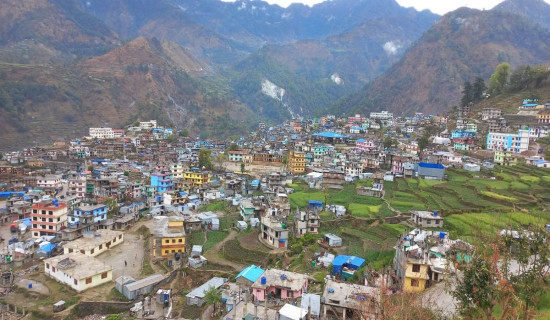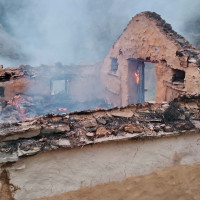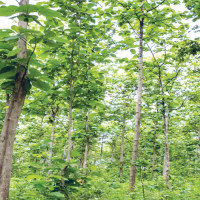- Monday, 19 January 2026
Climate Change Exacerbates Forest Fires
Climate change and forest fires are critical issues affecting Nepal severely. The devastating consequences of climate change are leading to an alarming surge in forest fires that ravage the natural environment. Climate change is caused by natural internal processes or external forces such as modulations of solar cycles, volcanic eruptions, and persistent anthropogenic changes in the composition of the atmosphere or land use. Many places have seen changes in rainfall, resulting in more floods, droughts, intense rain, severe heat waves, and ultimately helping to cause forest fires and wildfires. Globally, climate change impacts are seen as warm oceans, acidic water, melting of ice caps, and rising sea levels, among others.
Nepal cannot escape the rapidly increasing influence of climate and global changes. Within a few hundred kilometres, the country’s elevation changes from 70 metres low in Terai to the top of Mount Everest (8848.86 metres). The rapidly retreating glaciers (average retreat of more than 30 m/year), the rapid rise of temperature (>0.006 degrees Celsius per year), erratic rainfalls, and the increase in the frequency of disasters like floods and droughts and mean rainfall. Mean rainfall has significantly decreased by an average of 3.7mm, which forms drought areas in most places and ultimately causes forest fires. Nepal is a mountainous country, making it most vulnerable due to increased warming trends as well as extreme changes in altitude over shorter distances. Most of the big rivers in Nepal have a glacier-fed, complex climate driven by these varying terrains and regional weather systems. Climate change has direct effects on temperature rise, agriculture, food production, livestock production, hydroelectricity, livelihood, and economy, and causes different types of disasters like floods, landslides, droughts, and forest fires.
Many of the effects of climate change are likely to affect the poorest groups in society, as there will be a risk to productivity in labour jobs due to extreme heat stress and heat waves. Nowadays, the climate department is time and again giving notice to remain safe and sound because heat waves are increasing due to the increase in temperature in terai regions. Many water-borne and vector-borne diseases are prevalent in Nepal, like malaria, dengue, chikungunya, and Japanese encephalitis, due to climate change. Eye infection problems are seen in the Bharatpur area due to air pollution from forest fires. Most pandemics are seen on low land in Terai and hills in Nepal, with 80 per cent of the population at risk.
Forest fires
Forest fires are uncontrolled fires occurring in vegetation and biomass in forests greater than 1.8 metres (6 feet) in height. It is an unplanned, uncontrolled, and unpredictable fire in an area of combustible vegetation. Rising temperatures, prolonged droughts, and seasonal changes in rainfall patterns are some of the evidence of climate change that triggers an increase in forest fires globally. The National Climate Change Policy 2019 recognises forest fires as one of the climate-induced disasters. A study shows the mean temperature is likely to increase in the future by 1.5 to 2.8 degrees Celsius in the long term (2036–2065) in the country, and forest fire incidents will also increase in the same manner.
Globally, forest fires claim millions of dollars' worth of properties and lives. About 4 per cent of global forests burn every year due to climate change and human-induced interventions. Forests in Australia and the United States of America are a few examples that have resulted in invaluable forests, loss of biodiversity, and human deaths. In south Asia, more than half of the forest area was lost during 2003–2017 and is regarded as one of the largest forest fire hotspots in the world. Forest fires and wildfires not only contribute to the emission of greenhouse gases but also result in the loss of flora and fauna, forest biomass, leaf litter, herbs, and grasses that are considered important from a biodiversity point of view. Annually, about 3.3 million tonnes of carbon were found to be emitted during the last two decades. Thousands of houses and cattle sheds in proximity to forests have been lost due to forest fires over the last 20 years in Nepal. Among South Asian countries, Bangladesh has the highest number of forest fire hotspots (34 per cent), followed by India (32 per cent), and Nepal, with 29.5 per cent of forest areas likely to catch forest fire every year. In Nepal, about 590,000 hectares of forest were lost due to forest fires in 2016, which is the highest for the period 2001–2021. Developed countries have well-established mechanisms to tackle forest fires, like firefighting institutions, fire alert mechanisms, and early warning and awareness technologies. In Nepal, there have been some efforts like institutional setup and policies related to forest fires, but due to poor coordination between institutions and limited resources and technologies, a low level of awareness, difficult contour lands, sloppy terrains, a lack of proper human resources for forest management, anthropogenic drivers like distance of forest from road and settlement, etc., the implementation of forest management and forest fires is quite weak. Various human-induced causes, like smoking beehives, throwing burning matches haphazardly, vehicular sparks, carelessness by hikers and campers, travellers, garbage burners, mushroom collectors, etc., are responsible for forest fires.
Typically, Nepal experiences approximately 2,500 incidents of wildfires annually, with a majority (80 per cent) occurring between the last week of February and the last week of May, whereas about 60 per cent of forest fires occur in April alone. The period from mid-March to mid-May is particularly vulnerable, accounting for 60 per cent of reported forest fires. A study shows that 58 per cent of fires are the result of burning by grazers, poachers, hunters, and non-timber forest product collectors, 22 per cent due to negligence, and 20 per cent by accident in Nepal. People in rural areas still burn hay in their fields and near their houses for planting new crops and for fertiliser, and such activities have contributed to the spread of fires. Due to a lack of awareness in remote areas and a lack of strict laws, people knowingly and inadvertently start forest fires. Lumbini and Sudurpaschim provinces have reported the highest forest fire vulnerability. The incidence of forest fires is on the rise in Nepal and significantly contributes to forest degradation, forest loss, and greenhouse gas emissions. More than 200 forest fire incidents have already happened in the dry season of 2024. It occurred in places like Rukum, Myagdi, Gulmi, Humla, and Dolpa. Incidences of forest fires have led to a surge in air pollution in major cities such as Kathmandu, Pokhara, and Bharatpur. Air quality has deteriorated significantly, with Kathmandu ranking as the third most polluted city globally this afternoon, recording an Air Quality Index of 165.
Nepal has formulated a national action plan to reduce forest fires. Forest management practices should be done according to the proper forest management guidelines. For the protection of forest properties and lives, strict forest fire mitigation plans, policies, and practices ensuring sustainable forest fire management are to be made by the government. Strengthening local governments, imparting training to residents, providing them with the necessary kits to deal with fire incidents, and building artificial ponds are among the ways to deal with fires. Raising awareness of the consequences of deliberately causing forest fires and penalising those responsible could significantly reduce such incidents. We should also make people aware of the dangers of putting out fires. Awareness can be raised by various aspects, like incorporating climate change and forest fire topics into the academic syllabus, organising workshops, talk shows, and various brain-storming programmes at the national as well as local levels, and doing research and development on climate change issues.
(The author is an architect and urban planner at the Bharatpur Metropolitan City Office.)






-original-thumb.jpg)

-square-thumb.jpg)



-original-thumb.jpg)




